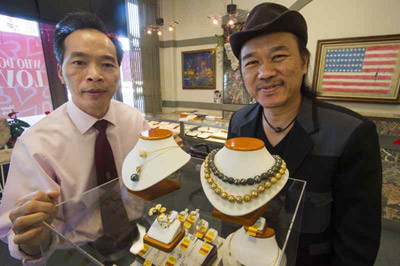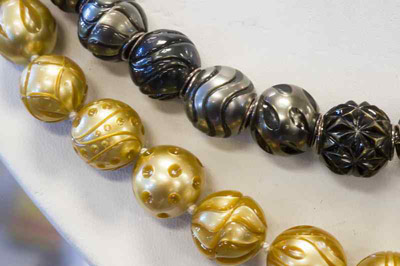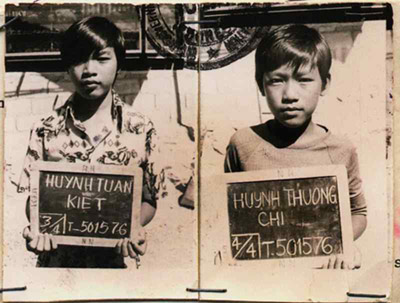From Pasadena Star-News March 2016
–
Two brothers from Vietnam survived pirates, harsh seas to find success in US as jewelry designers
–
–



By Michelle Mills, San Gabriel Valley Tribune
–
–
On a rainy night off the coast of Vietnam, two brothers said goodbye to everything they knew.
–
The Vietnam War had ended in 1975, but in 1981 life was still dangerous under the communist regime, so Kiet Huynh, 13, and Chi Huynh, 11, were sent off to America to find their older brother and seek out the opportunity for a better future.
–
“My mom took me to the temple and gave me a little ‘God bless,’ a paper that was supposed to protect me and my brother, and I put it in my pocket,” Kiet Huynh said. “We got on a boat with no idea where we were going.”
–
Under cover of darkness, the boys, along with more than 40 others, slipped out of Vietnam crammed on a tiny boat. But a few hours into the journey the boat’s engine died, leaving them adrift at sea. After several days, the group was rescued, given clean water to drink and allowed soothing showers.
–
The joy and relief quickly dissipated, however, as they realized that their saviors were actually pirates who took what little of value they had and put the group back on their small boat in the middle of the ocean.
–
“I had long pants and when I got to land they were short, because I cut off the pants to burn them and make a signal for people to see and rescue us,” Kiet Huynh said. “We had pirates and after a while we were afraid to see any boat coming close, because they might harm us or hurt us. So we ignored them and waited to die.”
–
Without power, the boat was at the mercy of the seas. As for its passengers, they found themselves without food or water except for what they could collect from occasional rainfall. Almost two weeks passed before a small fishing boat steered near to them and its captain offered to tow their vessel to shore.
–
Kiet Huynh and Chi Huynh ended up in a refugee camp in Thailand, where the brothers foraged for food and water to survive.
–
“Chi was little so he would sneak out of the camp and help the fishermen picking out the fishes, and they would give him a little bag of fish,” Kiet Huynh said.
–
Kiet Huynh tried his luck at this, but he was older so the fishermen would chase him off, telling him to go back to camp.
–
Finally, Church World Service reunited the boys with their older brother, who had resettled in America and was living in Rosemead.
–
Dropped into the unfamiliar surroundings of their new country, Kiet and Chi had no choice but to move forward, trying to learn their new language and culture.
–
“It was hard, because you get kids making fun of you, because you don’t speak the language,” Kiet Huynh said. “You’re just different and they don’t understand, so they make fun of you. You hope one day they will understand.”
–
The Huynhs’ father had been a jeweler, and the boys had spent time in his workshop before the communists took everything the family had. They also knew their dad wanted something different, something better for them than working in the jewelry business. Despite these career expectations, Chi Huynh followed his heart and left California to attend art school in Maryland.
–
His brother Kiet, however, said he “tried to be a good kid” and went to Cal Poly Pomona to study engineering. But after two years, his passion for jewelry making won out, and he quit the program. In 1989, Kiet Huynh opened a small jewelry store in San Dimas with a cousin.
–
And then the brothers started creating.
–
Today, Kiet is a master goldsmith and the owner of Adamas Jewelers in San Dimas. Chi is an accomplished painter and an innovator in the pearl industry with his company, Galatea Jewelry by Artist, also in San Dimas. The brothers work together as jewelry designers creating the pieces on display in Kiet Huynh’s store.
–
“Actually, I didn’t care that much about pearls when I went into the jewelry business, but one day I decided to make jewelry to give to my fiancee before I got married,” Chi Huynh said. “I decided I wanted to express the meaning of love, what love really means to me.
–
“I think it’s easy for people to love in the good times, when everything is perfect, but when it’s the difficult time of your life and you still love that person, that’s really love. I thought of a gem, the only gem that is created by an animal is a pearl and a pearl is created because of the pain, the discomfort, and the oyster decided to polish it so that it doesn’t hurt itself and in time it makes a beautiful pearl.”
–
To make his gift extra special, Chi Huynh decided to drill a hole into a pearl and fill it with a diamond. Several pearls cracked in the process, but Chi noticed the striking difference of the inner layers. Inspired, he began carving pearls, carefully grinding through their shiny exteriors and creating intricate patterns by exposing the matte nuclei inside.
–
Chi Huynh has now been carving pearls for 17 years.
–
“Carving a pearl is taboo,” Chi said. “The value of a pearl is how smooth it is, so to any person in the jewelry business thinking of carving a pearl is insane. You don’t do that. But I’m an artist, so I’m interested in expressing what it means to me rather than the value.”
–
An artist also is intrigued by color, so Chi Huynh tried painting the exposed areas on the pearls and then thought how beautiful his work would be if his carving would reveal a colorful gemstone inside. He contacted pearl farmers to try to do this and every one he asked told Chi that his idea wasn’t possible. He kept thinking about it and finally came up with a process to trick the oysters into accepting the gems and coating them, creating an outer pearl around the gem.
–
Chi traveled to Tahiti to work on what would become the Galatea Pearl. It took five years to fully develop and test his process, as it takes about 18 months for an oyster to produce a pearl. But as beautiful as his creations were, he could not bring them into the United States because of the Pearl Rule, a law which states that only natural, white shell nucleus pearls from Mississippi may be used in the American jewelry industry.
–
“I don’t feel like I’m doing something wrong; I’m an inventor,” Chi said. “Unfortunately, they made this law before I existed, so I have no place to go.”
–
As Chi Huynh worked to get the law changed, he returned home to the China Sea of Vietnam and continued working with his pearls. He believes that it’s a mix of his perseverance and the flagging economy that finally led to an amendment of the Pearl Law in 2010, which allowed him to bring his work to the United States.
–
Since then, Chi has won numerous awards for his Galatea Jewelry by Artist line, including the Cultured Pearl Association of America’s International Pearl Design Competition’s Designer’s Award in 2012 and Visionary Award in 2013.
–
For his work, it takes two to six hours for Chi Huynh to carve each pearl freehand.
–
“The reason you have to do it by hand is that every pearl is not the same,” Chi said. “You cannot put it through a machine. It doesn’t know the shape, and every shape is different.”
–
He uses a small motorized etching knife to slowly chisel a design into the pearl, gradually revealing its plain matte nucleus or a gemstone, such as amethyst, topaz, citrine or turquoise. All of his designs are inspired by nature.
–
The innovative side of Chi Huynh hasn’t been idle, either. While doing research for a business application, he learned about near field communication technology, and over the past two years he has been incorporating the wireless technology into his jewelry line.
–
A tiny chip is placed in the pearl through farming or by drilling. The person who purchases the finished jewelry then uses their cellphone to download a photo, video or recorded message onto the chip, allowing the jewelry recipient to play back the message by lightly tapping the piece to their phone. The data can be updated or moved to another piece of similarly enabled jewelry at a later time. It is only compatible with Android products.
–
“It is a fairly interesting way for you to record the history of your life,” Chi Huynh said. “Imagine 50 years from now when you give it to your son: You say, ‘Son, everything about the day you were born is in here.’ ”
–
Galatea Jewelry by Artist manufactures in both the United States and Vietnam, employing more than 150 people and sells to around 1,500 retail jewelers across America. Its pieces start at $75 for one carved pearl on a silver chain.
–
The Huynh brothers can easily be called an American success story, but they are still working hard to nurture the dream that was thrust on them.
–
“You just try to look beyond what people think, because if you get discouraged and you get mad it doesn’t do you any good because I’m already here,” Kiet Huynh said. “My parents sent me away and I didn’t know why. I slowly understood that it’s better for me so I tried to accept it. … I found out that it’s not that difficult if you try. If you try, you will succeed.
–
“Whatever you do, do it from your heart. There will always be a sad part to anything, but learn to accept life, accept what has come to you and try to make a better thing out of it.”
